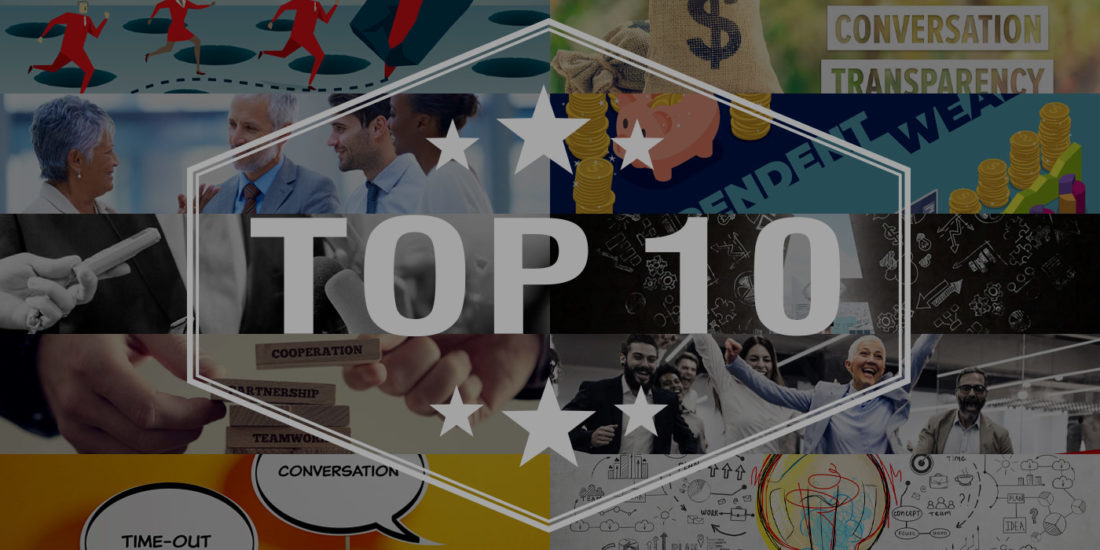The Benefits of Rest, Reprieve, Relaxation, and Rejuvenation
Two types of stress punctuate personal experience. Eustress (pleasant or curative stress) is inspirational and motivational. Distress destroys. Work-life balance depends on a manageable mix between the two and mismanagement has serious consequences. The clients with whom the distressed professionals interact may detect the symptoms before the advisor/consultant does. In this article John Lanier says the antidote to distress is rest, reprieve, relaxation, and rejuvenation. He offers suggestions on ways to achieve a work-life balance that includes fun.
Stress literally kills. However, the corpse may be more than a physiological casualty. Stress may also impair the creative juices of innovation. By example, consider this hyperbolic leader-to-subordinate directive: Invent a pancreatic cancer immunization by 7:00AM tomorrow morning. The spectrum of reality lies within (i) impossible immediacy and (ii) indefinite impracticality. The plot along the spectrum for most people is likely skewed toward “impossible immediacy.” The economic reality of both parents needing to work to make ends meet—exacerbated by single parent households—often relegates professionals to indentured servanthood to income production. Overshadowing this picture is the possibility of corporate downsizing that increases the workload across fewer resources.
Although professionals may comprehend the merits of rest, reprieve, relaxation, and rejuvenation, they may not think plausible any realistic work-life balance relief. Indeed, even those who actually take vacations are more likely than not to take their work with them—and this to the detriment of their families who are hungry to reconnect with their loved one. Consequently, actual enjoyment is elusive. This article first endeavors to create an appetite for restoration before setting the table with options.
The Crucible of Pain
One of the hazards of entrepreneurism is the resistance to delegation. Eventually, the business may outgrow the leader’s ability to control it. In bigger organizations, managers who cannot let go may be forfeiting promotion opportunities. Credible research concludes that superhuman multitasking is mythical. As far back as Adam Smith, continuing through Frederic Taylor, later with B.F. Skinner, and more recently with Daniel Kahneman, evidence points toward a positive correlation between tighter focus, efficiency, and effectiveness. The contrasting reality for many is depressing. Before an executive may relax, she may need confidence that the place will still exist upon her return. How, then, may a leader get a handle on mitigating the risk of taking time off? Root cause analysis may come in many forms.
One means of anchoring perspective is the simple calendar test. This technique identifies where the executive actually spends his or her time. Accordingly, areas of delegation may be identified. Tracking how a leader actually spends their time may also reveal something more sinister: reverse delegation. As William Oncken, Jr. and Donald L. Wass describe in their classic 1999 Harvard Business Review article, “Management Time: Who’s Got the Monkey?,” executives may unwittingly indulge reverse delegation by allowing subordinates to return the “monkey” on their backs to the boss. This may be a signal for coaching and training—for both boss and subordinate. A simple leader response might be “What would you do if I were not here?” If the risk is reasonable, the boss’ response might be “Pretend I am not here.”
Process mapping the basic business model is another technique for identifying how the place works. Several possibilities emerge from the discoveries. First, unnecessary activity may be eliminated for everyone’s benefit. Second, a different flow may improve efficiencies and relieve some pressure. Third, the workflow documentation may signal needed refinement in roles and responsibilities. Finally, the map may reveal measurements whose creation might improve exceptions management.
In summing up the leadership challenge, insights from Lee Iacocca are noteworthy. Iacocca, famous for turning around Chrysler in the 70s, said that the inability to schedule a vacation was a sign of a poor manager. Even amid the stress of turning around his battleship in a bathtub, Iacocca appreciated the restorative benefits of rest, reprieve, relaxation, and rejuvenation. Such recuperative breaks may avert burnout. We should also recall that Iacocca was operating in an economic environment quite similar to the one prevailing today.
How does one know that they are suffering from stress? Simple signals may be enough. Dr, Gary Small, in The Memory Bible: An innovative Strategy for Keeping Your Brain Young, imparts four categories: (i) physical, e.g., insomnia; (ii) emotional, e.g., depression; (iii) mental, e.g., diminished concentration; and (iv) behavioral, e.g., binge drinking. Of course, each category may have forms ranging from mild to extreme, but they are nonetheless telltale signs.
Weighty Words: Definitions with Implied Goals
Definitions for rest, reprieve, relaxation, and rejuvenation contribute to the argument. Rest is the opposite of work. The mind and body require relief from their daily routine sufficient to recharge. Sleep is a form of rest. Beyond providing the musculoskeletal framework a break, one reason medical professionals recommend eight hours of sleep is to permit the brain to digest data accumulated throughout the day. Not only do people filter an overwhelming volume of input during the day to absorb specific content, they need time to sort and synthesize those data for retrieval from long term memory. Another valid reason for sufficient nightly rest is that research debunks the myth that a single “catch-up” slumber reverses extended periods of sleep deprivation.
Reprieve is another refreshment technique. In extreme situations, e.g., labor contract negotiations, a reprieve permits a break for cooling off and thinking through the implications. The pros and cons of vetted options may avoid the unintended consequences of missteps. These principles are reinforced in Roger Fisher, William L. Ury, and Bruce Patton’s must read, Getting to Yes: Negotiating Agreement without Giving In. In less extreme situations, a strategic nap affords a bit of personal refreshment. For example, President Ronald Reagan was a fan of a midday nap. Perhaps one reason that he was considered a composed and effective communicator is that he paced himself to digest his workload.
Relaxation need not be associated with vacations. Whereas weekends may be the default medium for relaxation, weekdays should not be overlooked. Relaxation entails letting go and disconnecting from the source of stressors. Exercise may seem counterintuitive. However, exercise produces endorphins, increases stamina, and tunes up the cardiovascular system. Some executives opt for amateur sports. Even the simplicity of a stroll may be cathartic. Yoga is an ancient, holistic form of exercise and relaxation that enjoys a large following. Late adopters may find solace in Alice Christensen’s Easy Does It Yoga, in which she states that 53 is a good age to start! Basically, anything that diminishes stress reduces cortisol—a stress exacerbating hormone.
A balanced diet should also be considered. In addition to content, quantity should be managed. It is hard to rest when the spices from our Thai food junket are burning a hole in our stomachs. Moreover, gluttony builds fat cells that literally last forever—or at least until opting for liposuction. First, it makes practical sense that we should not consume more calories than we burn. Second, we should remember that our metabolism slows with age. Therefore, less caloric fuel is required to run our engines.
Hobbies are another alternative. Hobbies, or avocations, engage the mind and body through a type of diversion. English Prime Minister Winston Churchill painted. Academy Award winner Henry Fonda built model airplanes. Hobbies sometimes distract the mind enough to permit breakthrough, creative epiphanies to leap into conscious thought. Weekends in a different venue are also beneficial. Urbanites may opt for a long weekend in the mountains or the beach. A final thought about relaxation regards activities with associates, e.g., paintball. For relaxation with associates to qualify, the group must agree that work-related topics are off-limits.
Rejuvenation reinvigorates the soul. In extreme examples, sabbaticals extricate executives from their normal work environment for a course deviation lasting several weeks to months. The more common form of rejuvenation is the vacation. However, preemptive steps make sense to establish a firewall between the office and the excursion. Ground rules and venue are practical options. Ground rules include leaving the personal computer and smart phone behind. A better form of firewall is a place where connectivity is problematic. For example, a whitewater rafting trip or a horseback expedition through a mountain range may fit the bill.
Conclusion
Whereas eustress is inspirational and motivational, distress is both counterproductive and unhealthy. Chip and Dan Heath inform us in their book, Switch: How to Change Things When Change is Hard, that we expend more energy enduring tense situations. Eventually, we simply exhaust our stamina. When teammates approach burnout, normally inspirational stress may be perceived as distressful. The ability of an organization to embrace the benefits of rest, reprieve, relaxation, and rejuvenation begins with behaviors modeled by senior leaders. Signals that should catch leaders’ attention are poor morale, lost productivity, absenteeism, and turnover.
Charles Handy’s sigmoid curve theoretically depicts the business lifecycle. The curve approximates a sine wave whose cycles’ trend line has a positive slope. When a cycle nears an apex of zero slope, the company must reinvent itself or face deterioration—and perhaps extinction. A leader’s restorative intervention for her team may induce the “phoenix effect” that rekindles positive slope on another cycle.
A career irony is that health is sometimes spent acquiring wealth. Subsequently, wealth is exhausted trying to regain health. Averting this insanity is a better alternative. The apex of Maslow’s Hierarchy of Needs is self-actualization, which includes the non-monetary intrinsic rewards. As implied by the title of Gretchen Rubin’s book, The Happiness Project: Or, Why I Spent a Year Trying to Sing in the Morning, Clean My Closets, Fight Right, Read Aristotle, and Generally Have More Fun, professionals have to take ownership of a work-life balance that includes fun.
Leaders should foster work environments that facilitate enjoyment. Southwest Airlines is the poster child for this phenomenon. The company deliberately recruits people who are naturally disposed to smile, knowing that they will routinely encounter customer service conflict throughout a typical day. Moreover, the company places the welfare of its employees ahead of both customers and stockholders, rationalizing that fulfilled employees correlate highly with favorable outcomes for omnibus stakeholders. Southwest’s historical performance vindicates their strategy.
Confucius counseled, “Choose a job you love, and you will never have to work a day in your life.” A beloved vocation is capable of symbiosis with rest, reprieve, relaxation, and rejuvenation. When work ceases to be fun, it is time to ask “Why?” with the resolve to do something about it.
About the Contributor
 John A. Lanier is founder and CEO of Middle Market Methods™, a consulting firm serving portfolio companies of middle market private equity firms. Lanier mentors clients with a “value creation road map” of leadership and process improvement solutions that “operationalize” the investment thesis. Contact Lanier at jalanier@middlemarketmethods.com
John A. Lanier is founder and CEO of Middle Market Methods™, a consulting firm serving portfolio companies of middle market private equity firms. Lanier mentors clients with a “value creation road map” of leadership and process improvement solutions that “operationalize” the investment thesis. Contact Lanier at jalanier@middlemarketmethods.com
Stay tuned next week for another issue of The Practitioner.
Yours in Practice,
The Practitioner





